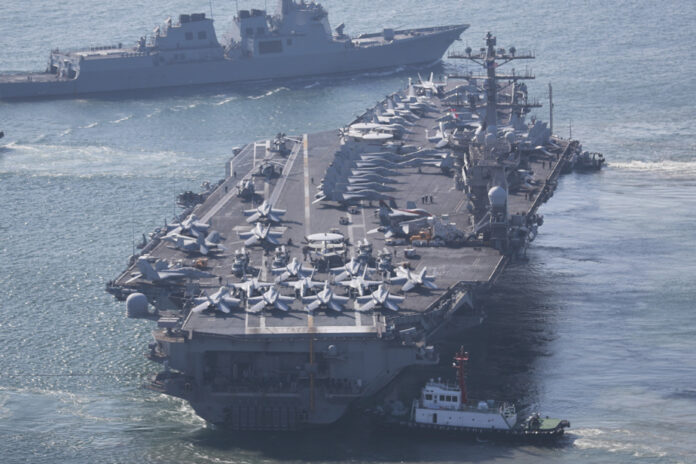(Seoul) The South Korean, U.S. and Japanese maritime militaries began their first anti-submarine drills in six months on Monday to strengthen coordination against rising North Korean missile threats, the South’s military said. -Korean.
The two-day drills come as North Korea recently unveiled a type of battlefield nuclear warhead, sparking concerns the country could conduct its first nuclear test since 2017.
The maritime exercises in international waters off Jeju Island in southern South Korea involved the nuclear-powered aircraft carrier USS Nimitz and destruction ships from South Korea, the United States United States and Japan, the South Korean Defense Ministry said in a statement.
The training was organized to improve the three countries’ abilities to respond to undersea security threats posed by North Korea’s submarine-launched ballistic missiles and other assets, the statement said. He said the three countries were to detect and track South Korean and American unmanned underwater vehicles posing as enemy submarines and other assets.
Missiles launched by North Korean submarines pose serious threats to the security of the United States and its allies, as it is more difficult to spot such launches in advance. In recent years, North Korea has tested sophisticated underwater-launched ballistic missiles and pushed to build larger submarines, including a nuclear-powered one.
Last month, North Korea conducted a series of missile tests in response to bilateral military exercises between South Korea and the United States. Weapons tested included a nuclear-capable underwater drone and a submarine-launched cruise missile, suggesting North Korea is trying to diversify its types of underwater weapons.
Photographs published last week in North Korean state media showed about 10 red-tipped capsule-shaped warheads called “Hwasan (volcano)-31” with different serial numbers. A poster on a nearby wall listed eight types of short-range weapons that could carry the “Hwasan-31” warhead. Previous test flights of these weapons show they are capable of hitting key targets in South Korea, including US military bases there.
Some observers say the unveiling of the warhead could be a harbinger of a nuclear test, as North Korea’s last two tests in 2016 and 2017 followed revelations of other warheads. If it were to carry out a nuclear test, it would be its seventh explosion overall and the first since September 2017.
Foreign experts question whether North Korea has functioning nuclear missiles. But South Korea’s Defense Minister Lee Jong-Sup recently said North Korea’s technology to build miniaturized warheads to mount on advanced short-range missiles has made significant progress.
North Korea may conduct new missile tests in response to South Korea-US-Japan drills, as it sees such training as a threat to its security. North Korean leader Kim Jong-un called recent U.S.-South Korean drills “irresponsible military provocations” that disregard North Korea’s “patience and warning.”
In remarks included in the Ministry of Defense statement, Rear Admiral Kim Inho, head of the South Korean forces participating in the trilateral exercises, said: “We will respond decisively and neutralize any kind of provocation from North Korea “.
In addition to anti-submarine drills, the three countries will practice humanitarian search and rescue operations, including rescuing people in the water and treating patients in emergency situations. It would be the first such formation of the three countries in seven years, according to the press release from the Ministry of Defense.


















